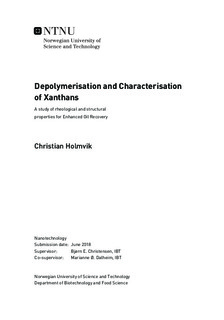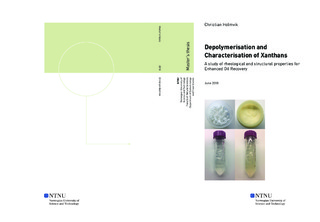| dc.description.abstract | Xanthan is a polysaccharide which is commonly used as a thickening agent in e.g. sauces and toothpastes due to its viscosifying properties. The same attributes make it applicable for Enhanced Oil Recovery (EOR). With today's increased focus on making a more environmentally friendly oil industry, xanthan has received renewed interest due to being non-hazardous and to some degree biodegradable. It has furthermore been shown that certain chemical substitutions can make it possible to improve xanthan's rheological properties and control its degradability. First, however, it is necessary to thoroughly characterise non-modified xanthans to create a basis for evaluating the effects of such modifications.
In this master's thesis, non-modified xanthans have been studied using various analytical methods. All samples originate from two separate industrial products. The first, called MX, has been purified directly from a fermentation broth produced by IRIS AS. The second xanthan was manufactured by CP Kelco under the name Kelzan XCD, and will hereafter be referred to as XCD. The master s project is a continuation of the work carried out during the preceding specialisation project of 2017, where the following main results were found: By thermogravimetric analysis (TGA), the moisture content of MX was shown to be (10.43 ± 0.05)%. A Star Burst Mini microfluidiser was further used to degrade MX and XCD by high pressure mechanical shear, yielding xanthan samples with different molecular weight distributions. Flow-through-times of all samples were measured by capillary viscometry in order to determine their intrinsic viscosities at a shear rate of 2500 per second. For both MX and XCD, the results indicated that continued mechanical shear degradation would approach a lower limit for intrinsic viscosity of approx. 200 mL/g provided the conditions remained the same. Size exclusion chromatography combined with multi-angle laser light scattering (SEC-MALLS) indicated a corresponding limit for the weight average molecular weight of mechanically degraded MX to be about 400-500 kDa, while the results for XCD were too inaccurate for making such a prediction.
In the master's project, a Kinexus ultra+ rotational rheometer was used to study the dependence of dynamic viscosity on shear rate for undegraded MX and XCD in alkaline solutions of various concentrations. Samples containing MX were found to have slightly higher viscosities than XCD under the same conditions. Structural analyses of the xanthans with proton nuclear magnetic resonance spectroscopy (H-NMR) were carried out for comparing samples that had been degraded either chemically with H2O2/NaOH or enzymatically using the cellulases BGI-30 and Ecostone Goo. Optimisation of the depolymerisation protocols was done by analyses using the bicinchoninic acid (BCA) reducing end assay and spectrophotometry. It was shown that degradation with H2O2/NaOH causes a high degree of deacetylation, while the amount of free acetate in samples depolymerised by cellulases were negligible. Ideal H-NMR spectra were not obtained for any of the degraded MX samples, although the results indicated that MX is close to fully acetylated and pyruvated as the respective degree of substitutions were calculated to be DS_{Ac, MX} = 1.48 and DS_{Pyr, MX} = 1.28. On the other hand, XCD samples appeared to be sufficiently depolymerised for obtaining good spectra, resulting in DS_{Ac, XCD} = 0.97 and DS_{Pyr, XCD} = 0.61. This indicates that XCD has a significantly lower pyruvyl content compared to MX, which might have consequences for potential chemical modifications. | |

